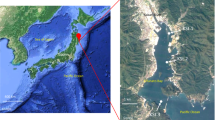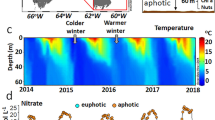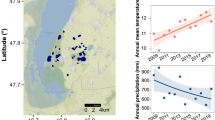Abstract
Many eukaryotic communities exhibit predictable seasonality in species composition, but such phenological patterns are not well-documented in bacterial communities. This study quantified seasonal variation in the community composition of bacterioplankton in a high-elevation lake in the Sierra Nevada of California over a 3-year period of 2004–2006. Bacterioplankton exhibited consistent phenological patterns, with distinct, interannually recurring community types characteristic of the spring snowmelt, ice-off and fall-overturn periods in the lake. Thermal stratification was associated with the emergence of specific communities each summer and increased community heterogeneity throughout the water column. Two key environmental variables modulated by regional meteorologic variation, lake residence time and thermal stability, predicted the timing of occurrence of community types each year with 75% accuracy, and each corresponded with different aspects of variation in community composition (orthogonal ordination axes). Seasonal variation in dissolved organic matter source was characterized fluorometrically in 2005 and was highly correlated with overall variation in bacterial community structure (rMantel=0.75, P<0.001) and with the relative contributions of specific phylotypes within the Cyanobacteria, Actinobacteria and β-Proteobacteria. The seasonal dynamics of bacterial clades (tracked through coupling of randomized clone sequence libraries to restriction fragment length polymorphism fingerprints) matched previous results from alpine lakes and were variously related to solute inputs, thermal stability and temperature. Taken together, these results describe a phenology of high-elevation bacterioplankton communities linked to climate-driven physical and chemical lake characteristics already known to regulate eukaryotic plankton community structure.
Similar content being viewed by others
Log in or create a free account to read this content
Gain free access to this article, as well as selected content from this journal and more on nature.com
or
References
Beniston M, Diaz HF, Bradley RS . (1997). Climatic change at high elevation sites: an overview. Clim Change 36: 233–251.
Biddanda B, Ogdahl M, Cotner J . (2001). Dominance of bacterial metabolism in oligotrophic relative to eutrophic waters. Limnol Oceanogr 46: 730–739.
Boyer EW, Hornberger GM, Bencala KE, McKnight DM . (1997). Response characteristics of DOC flushing in an alpine catchment. Hydrol Process 11: 1635–1647.
Brown MV, Schwalbach MS, Hewson I, Fuhrman JA . (2005). Coupling 16S-ITS rDNA clone libraries and automated ribosomal intergenic spacer analysis to show marine microbial diversity: development and application to a time series. Environ Microbiol 7: 1466–1479.
Carlson CA, Ducklow HW, Hansell DA, Smith WO . (1998). Organic carbon partitioning during spring phytoplankton blooms in the Ross Sea polynya and the Sargasso Sea. Limnol Oceanogr 43: 375–386.
Carlson CA, Giovannoni SJ, Hansell DA, Goldberg SJ, Parsons R, Otero MP et al. (2002). Effect of nutrient amendments on bacterioplankton production, community structure, and DOC utilization in the northwestern Sargasso Sea. Aquat Microb Ecol 30: 19–36.
Carlson CA, Giovannoni SJ, Hansell DA, Goldberg SJ, Parsons R, Vergin K . (2004). Interactions among dissolved organic carbon, microbial processes, and community structure in the mesopelagic zone of the northwestern Sargasso Sea. Limnol Oceanogr 49: 1073–1083.
Carrera G, Fernandez P, Grimalt JO, Ventura M, Camarero L, Catalan J et al. (2002). Atmospheric deposition of organochlorine compounds to remote high mountain lakes of Europe. Environ Sci Technol 36: 2581–2588.
Carrillo P, Medina-Sanchez JM, Villar-Argaiz M . (2002). The interaction of phytoplankton and bacteria in a high mountain lake: Importance of the spectral composition of solar radiation. Limnol Oceanogr 47: 1294–1306.
Cayan DR, Kammerdiener SA, Dettinger MD, Caprio JM, Peterson DH . (2001). Changes in the onset of spring in the western United States. Bull Am Meteorol Soc 82: 399–415.
Chapin FS, Zavaleta ES, Eviner VT, Naylor RL, Vitousek PM, Reynolds HL et al. (2000). Consequences of changing biodiversity. Nature 405: 234–242.
Clarke KR, Ainsworth M . (1993). A method of linking multivariate community structure to environmental variables. Mar Ecol Prog Ser 92: 205–219.
Conrad R . (1996). Soil microorganisms as controllers of atmospheric trace gases (H2, CO, CH4, OCS, N2O, and NO). Microbiol Rev 60: 609–640.
Cotner JB, Ammerman JW, Peele ER, Bentzen E . (1997). Phosphorus-limited bacterioplankton growth in the Sargasso Sea. Aquat Microb Ecol 13: 141–149.
Cotner JB, Biddanda BA . (2002). Small players, large role: microbial influence on biogeochemical processes in pelagic aquatic ecosystems. Ecosystems 5: 105–121.
Cottrell MT, Kirchman DL . (2000). Natural assemblages of marine proteobacteria and members of the Cytophaga-Flavobacter cluster consuming low- and high-molecular-weight dissolved organic matter. Appl Environ Microbiol 66: 1692–1697.
Covert JS, Moran MA . (2001). Molecular characterization of estuarine bacterial communities that use high- and low-molecular weight fractions of dissolved organic carbon. Aquat Microb Ecol 25: 127–139.
Crump BC, Hobbie JE . (2005). Synchrony and seasonality in bacterioplankton communities of two temperate rivers. Limnol Oceanogr 50: 1718–1729.
Crump BC, Kling GW, Bahr M, Hobbie JE . (2003). Bacterioplankton community shifts in an arctic lake correlate with seasonal changes in organic matter source. Appl Environ Microbiol 69: 2253–2268.
Curtis TP, Sloan WT . (2004). Prokaryotic diversity and its limits: microbial community structure in nature and implications for microbial ecology. Curr Opin Microbiol 7: 221–226.
DeSantis TZ, Hugenholtz P, Keller K, Brodie EL, Larsen N, Piceno YM et al. (2006a). NAST: a multiple sequence alignment server for comparative analysis of 16S rRNA genes. Nucleic Acids Res 34: W394–W399.
DeSantis TZ, Hugenholtz P, Larsen N, Rojas M, Brodie EL, Keller K et al. (2006b). Greengenes, a chimera-checked 16S rRNA gene database and workbench compatible with ARB. Appl Environ Microbiol 72: 5069–5072.
Felsenstein J . (2005). PHYLIP (Phylogeny Inference Package). Distributed by the author. Department of Genome Sciences, University of Washington, Seattle, WA, USA.
Fenn ME, Baron JS, Allen EB, Rueth HM, Nydick KR, Geiser L et al. (2003). Ecological effects of nitrogen deposition in the western United States. Bioscience 53: 404–420.
Finlay BJ . (2002). Global dispersal of free-living microbial eukaryote species. Science 296: 1061–1063.
Fuhrman JA, Hewson I, Schwalbach MS, Steele JA, Brown MV, Naeem S . (2006). Annually reoccurring bacterial communities are predictable from ocean conditions. Proc Natl Acad Sci USA 103: 13104–13109.
Fuhrman JA, Sleeter TD, Carlson CA, Proctor LM . (1989). Dominance of bacterial biomass in the Sargasso Sea and its ecological implications. Mar Ecol Prog Ser 57: 207–217.
Glockner FO, Zaichikov E, Belkova N, Denissova L, Pernthaler J, Pernthaler A et al. (2000). Comparative 16S rRNA analysis of lake bacterioplankton reveals globally distributed phylogenetic clusters including an abundant group of actinobacteria. Appl Environ Microbiol 66: 5053–5065.
Grant A, Ogilvie LA . (2004). Name that microbe: rapid identification of taxa responsible for individual fragments in fingerprints of microbial community structure. Mol Ecol Notes 4: 133–136.
Hall TA . (1999). BioEdit: a user-friendly biological sequence alignment editor and analysis program for Windows 95/98/NT. Nucl Acids Symp Ser 41: 95–98.
Haukka K, Kolmonen E, Hyder R, Hietala J, Vakkilainen K, Kairesalo T et al. (2006). Effect of nutrient loading on bacterioplankton community composition in lake mesocosms. Microb Ecol 51: 137–146.
Hewson I, Fuhrman JA . (2006). Improved strategy for comparing microbial assemblage fingerprints. Microb Ecol 51: 147–153.
Hood E, McKnight DM, Williams MW . (2003). Sources and chemical character of dissolved organic carbon across an alpine/subalpine ecotone, Green Lakes Valley, Colorado Front Range, United States. Water Resour Res 39: 1188–1199.
Hood E, Williams MW, McKnight DM . (2005). Sources of dissolved organic matter (DOM) in a Rocky Mountain stream using chemical fractionation and stable isotopes. Biogeochemistry 74: 231–255.
Huber T, Faulkner G, Hugenholtz P . (2004). Bellerophon: a program to detect chimeric sequences in multiple sequence alignments. Bioinformatics 20: 2317–2319.
Hullar MAJ, Kaplan LA, Stahl DA . (2006). Recurring seasonal dynamics of microbial communities in stream habitats. Appl Environ Microbiol 72: 713–722.
Idso SB . (1973). On the concept of lake stability. Limnol Oceanogr 18: 681–683.
Judd KE, Crump BC, Kling GW . (2006). Variation in dissolved organic matter controls bacterial production and community composition. Ecology 87: 2068–2079.
Kan JJ, Crump BC, Wang K, Chen F . (2006). Bacterioplankton community in Chesapeake Bay: predictable or random assemblages. Limnol Oceanogr 51: 2157–2169.
Kent AD, Jones SE, Yannarell AC, Graham JM, Lauster GH, Kratz TK et al. (2004). Annual patterns in bacterioplankton community variability in a humic lake. Microb Ecol 48: 550–560.
Kent AD, Yannarell AC, Rusak JA, Triplett EW, McMahon KD . (2007). Synchrony in aquatic microbial community dynamics. ISME J 1: 38–47.
Kritzberg ES, Cole JJ, Pace MM, Graneli W . (2006a). Bacterial growth on allochthonous carbon in humic and nutrient-enriched lakes: results from whole-lake C-13 addition experiments. Ecosystems 9: 489–499.
Kritzberg ES, Langenheder S, Lindstrom ES . (2006b). Influence of dissolved organic matter source on lake bacterioplankton structure and function-implications for seasonal dynamics of community composition. FEMS Microbiol Ecol 56: 406–417.
Langenheder S, Lindstrom ES, Tranvik LJ . (2005). Weak coupling between community composition and functioning of aquatic bacteria. Limnol Oceanogr 50: 957–967.
Langenheder S, Lindstrom ES, Tranvik LJ . (2006). Structure and function of bacterial communities emerging from different sources under identical conditions. Appl Environ Microbiol 72: 212–220.
Letunic I, Bork P . (2007). Interactive Tree Of Life (iTOL): an online tool for phylogenetic tree display and annotation. Bioinformatics 23: 127–128.
Lindstrom ES . (1998). Bacterioplankton community composition in a boreal forest lake. FEMS Microbiol Ecol 27: 163–174.
Liu WT, Marsh TL, Cheng H, Forney LJ . (1997). Characterization of microbial diversity by determining terminal restriction fragment length polymorphisms of genes encoding 16S rRNA. Appl Environ Microbiol 63: 4516–4522.
MacIntyre S, Sickman JO, Goldthwait SA, Kling GW . (2006). Physical pathways of nutrient supply in a small, ultraoligotrophic arctic lake during summer stratification. Limnol Oceanogr 51: 1107–1124.
Margalef R . (1978). Life-forms of phytoplankton as survival alternatives in an unstable environment. Oceanol Acta 1: 493–509.
Martiny JBH, Bohannan BJM, Brown JH, Colwell RK, Fuhrman JA, Green JL et al. (2006). Microbial biogeography: putting microorganisms on the map. Nat Rev Microbiol 4: 102–112.
McCune B, Mefford MJ . (2006). PC-ORD v5. Multivariate Analysis of Ecological Data. MJM Software Design, Gleneden Beach, OR, USA.
McKnight DM, Boyer EW, Westerhoff PK, Doran PT, Kulbe T, Andersen DT . (2001). Spectrofluorometric characterization of dissolved organic matter for indication of precursor organic material and aromaticity. Limnol Oceanogr 46: 38–48.
Melack JM, Dozier J, Goldman CR, Greenland D, Milner AM, Naiman RJ . (1997). Effects of climate change on inland waters of the Pacific Coastal Mountains and Western Great Basin of North America. Hydrol Process 11: 971–992.
Melack JM, Stoddard JL . (1991). Sierra Nevada. In: Charles DF (ed), Acidic Deposition and Aquatic Ecosystems: Case Studies. New York: Springer-Verlag, pp 503–530.
Morales-Baquero R, Carrillo P, Barea-Arco J, Perez-Martinez C, Villar-Argaiz M . (2006a). Climate-driven changes on phytoplankton-zooplankton coupling and nutrient availability in high mountain lakes of Southern Europe. Freshw Biol 51: 989–998.
Morales-Baquero R, Pulido-Villena E, Reche I . (2006b). Atmospheric inputs of phosphorus and nitrogen to the southwest Mediterranean region: biogeochemical responses of high mountain lakes. Limnol Oceanogr 51: 830–837.
Morris RM, Vergin KL, Cho JC, Rappe MS, Carlson CA, Giovannoni SJ . (2005). Temporal and spatial response of bacterioplankton lineages to annual convective overturn at the bermuda atlantic time-series study site. Limnol Oceanogr 50: 1687–1696.
Ochman H, Lawrence JG, Groisman EA . (2000). Lateral gene transfer and the nature of bacterial innovation. Nature 405: 299–304.
Papke RT, Ward DM . (2004). The importance of physical isolation to microbial diversification. FEMS Microbiol Ecol 48: 293–303.
Perez MT, Sommaruga R . (2006). Differential effect of algal- and soil-derived dissolved organic matter on alpine lake bacterial community composition and activity. Limnol Oceanogr 51: 2527–2537.
Pernthaler J, Glockner FO, Unterholzner S, Alfreider A, Psenner R, Amann R . (1998). Seasonal community and population dynamics of pelagic bacteria and archaea in a high mountain lake. Appl Environ Microbiol 64: 4299–4306.
Pinhassi J, Sala MM, Havskum H, Peters F, Guadayol O, Malits A et al. (2004). Changes in bacterioplankton composition under different phytoplankton regimens. Appl Environ Microbiol 70: 6753–6766.
Prosser JI, Bohannan BJM, Curtis TP, Ellis RJ, Firestone MK, Freckleton RP et al. (2007). Essay—The role of ecological theory in microbial ecology. Nat Rev Microbiol 5: 384–392.
Psenner R . (1999). Living in a dusty world: Airborne dust as a key factor for alpine lakes. Water Air Soil Pollut 112: 217–227.
Reynolds CS . (2006). Ecology of Phytoplankton. New York: Cambridge University Press.
SAS-Institute (2007). JMP. SAS Institute: Cary, NC.
Schmidt W . (1928). Über die Temperatur- und Stabilitätsverhältnisse von Seen. Geografiska Annaler 10: 145–177.
Shade A, Kent AD, Jones SE, Newton RJ, Triplett EW, McMahon KD . (2007). Interannual dynamics and phenology of bacterial communities in a eutrophic lake. Limnol Oceanogr 52: 487–494.
Sickman JO, Leydecker A, Chang CCY, Kendall C, Melack JM, Lucero DM et al. (2003a). Mechanisms underlying export of N from high-elevation catchments during seasonal transitions. Biogeochemistry 64: 1–24.
Sickman JO, Melack JM, Clow DW . (2003b). Evidence for nutrient enrichment of high-elevation lakes in the Sierra Nevada, California. Limnol Oceanogr 48: 1885–1892.
Smayda TJ, Reynolds CS . (2001). Community assembly in marine phytoplankton: application of recent models to harmful dinoflagellate blooms. J Plankton Res 23: 447–461.
Smith RC, Bakers KS, Dustan P . (1981). Fluorometric techniques for the measurement of oceanic chlorophyll in the support of remote sensing. Ref Rep Scripps Institution of Oceanography (La Jolla, California) 81–17: 1–14.
Sommer U, Gliwicz ZM, Lampert W, Duncan A . (1986). The PEG-model of seasonal succession of planktonic events in fresh waters. Arch Hydrobiol 106: 433–471.
Sørensen TJ . (1948). A method of establishing groups of equal amplitude in plant sociology based on similarity of species content and its application to analysis of the vegetation of the Danish Commons. Biologiske Skrifter 5: 1–34.
Steinberg DK, Carlson CA, Bates NR, Johnson RJ, Michaels AF, Knap AH . (2001). Overview of the US JGOFS Bermuda Atlantic Time-series Study (BATS): a decade-scale look at ocean biology and biogeochemistry. Deep Sea Res Part II Top Stud Oceanogr 48: 1405–1447.
Stepanauskas R, Moran MA, Bergamaschi BA, Hollibaugh JT . (2003). Covariance of bacterioplankton composition and environmental variables in a temperate delta system. Aquat Microb Ecol 31: 85–98.
Stothard P . (2000). The sequence manipulation suite: JavaScript programs for analyzing and formatting protein and DNA sequences. Biotechniques 28: 1102–1104.
Valderrama JC . (1981). The simultaneous analysis of total nitrogen and total phosphorus in natural waters. Mar Chem 10: 109–122.
Walther GR, Post E, Convey P, Menzel A, Parmesan C, Beebee TJC et al. (2002). Ecological responses to recent climate change. Nature 416: 389–395.
Warnecke F, Sommaruga R, Sekar R, Hofer JS, Pernthaler J . (2005). Abundances, identity, and growth state of actinobacteria in mountain lakes of different UV transparency. Appl Environ Microbiol 71: 5551–5559.
Winder M, Schindler DE . (2004). Climatic effects on the phenology of lake processes. Glob Chang Biol 10: 1844–1856.
Yannarell AC, Kent AD, Lauster GH, Kratz TK, Triplett EW . (2003). Temporal patterns in bacterial communities in three temperate lakes of different trophic status. Microb Ecol 46: 391–405.
Yannarell AC, Triplett EW . (2005). Geographic and environmental sources of variation in lake bacterial community composition. Appl Environ Microbiol 71: 227–239.
Yu YN, Breitbart M, McNairnie P, Rohwer F . (2006). FastGroupII: A web-based bioinformatics platform for analyses of large 16S rDNA libraries. BMC Bioinformatics 7: 57–65.
Acknowledgements
I gratefully acknowledge Kevin Skeen for field assistance, J Jones for assistance with chlorophyll analysis, F Setaro for assistance with organic nutrient digestions, and B Clinton, A Engen and B Petty for conducting flow-injection and combustion elemental analysis. I am particularly indebted to JO Sickman and MA Anderson for their analysis of dissolved organic matter fluorescence. The comments of SD Cooper, CA Carlson and JM Melack greatly improved this paper. This study relied on the administrative support of Sequoia-Kings Canyon National Park and the UCSB Marine Science Institute. Financial support was provided by the University of California Water Resources Center Grant W988 to JM Melack and CA Carlson, NSF DDIG grant 0709975 to CE Nelson, and NSF grants 0089839 and 0614207 to JM Melack, JS Schimel and JO Sickman.
Author information
Authors and Affiliations
Corresponding author
Additional information
Supplementary Information accompanies the paper on The ISME Journal website (http://www.nature.com/ismej)
Supplementary information
Rights and permissions
About this article
Cite this article
Nelson, C. Phenology of high-elevation pelagic bacteria: the roles of meteorologic variability, catchment inputs and thermal stratification in structuring communities. ISME J 3, 13–30 (2009). https://doi.org/10.1038/ismej.2008.81
Received:
Revised:
Accepted:
Published:
Issue date:
DOI: https://doi.org/10.1038/ismej.2008.81
Keywords
This article is cited by
-
Thermal responses of dissolved organic matter under global change
Nature Communications (2024)
-
Resilience of planktonic bacterial community structure in response to short-term weather deterioration during the growing season in an alpine lake
Hydrobiologia (2020)
-
Diel population and functional synchrony of microbial communities on coral reefs
Nature Communications (2019)
-
Bacterial Diversity in Alpine Lakes: A Review from the Third Pole Region
Journal of Earth Science (2019)
-
Integrated biogeography of planktonic and sedimentary bacterial communities in the Yangtze River
Microbiome (2018)



